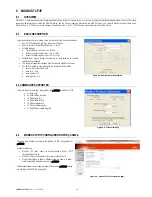
pCOWeb
+030220966 – rel. 1.1 – 12.12.2017
32
HOW THE RECORDS ARE SAVED
Whenever the specified time interval expires, the sampled values are added to a temporary file resident in VOLATILE memory; at 00 minutes each hour, the
data is downloaded to a file (history_diskbuffer) in proprietary format in NON-VOLATILE memory (/usr/local/root/flash/http/cache).
At midnight each day this file is recopied in .csv text format (compressed when enabled) in NON-VOLATILE memory accessible to the user, in the
“/usr/local/root/flash/http/log” directory, organised into monthly subdirectories (2017-11, 2017-12, etc...); the graph file is created (if enabled) in .svg format in
the same memory space.
The logging mode is optimised for a minimum number of writes to non-volatile memory, so as to reduce the degradation of the memory.
NOTE: in the event of power failures, this logging mode limits the maximum duration of data loss to one hour.
Nonetheless, the .csv / .svg files for the current day can be created manually, so as to obtain all the data saved until that moment with function Update files to
this very moment: see below.
In the “/usr/local/root/flash/http/log” directory,
pCOWeb
automatically saves the powerup-log.csv file containing the records, with the date / time of the events:
“Start firmware” and “Stop firmware”, respectively “Power-up” and “Power-down”. The latter is only written when the Stop follows a reboot while pressing the
physical button or selecting the button on the configuration page; in this way, two consecutive “Power-up” events indicate that there was a power failure
between the two events.
The .csv files and the graphs appear as shown in
Figure 5.g
.
The first line of the .csv files lists the types of variables enabled for logging, the second line the indices and the third the descriptions attributed; these are
followed by the lines with the records.
Figure 5.g - Logger and graphs: end results
LOGGER VIA E_MAIL
There is the possibility to send an e-mail at midnight every day. Just enable the sending logger in
Figure 5.h
Figure 5.h - Logger and graphs: e-mail configuration
Subject: It gives the object of the mail
Body: it allows to create a specific body for the mail sent, from a html file (downloaded via FTP or SCP in the http folder) or the body could be a text
typed directly in the empty field
















































